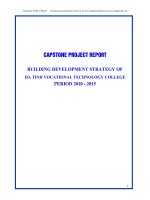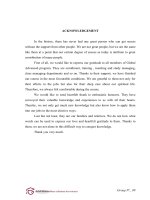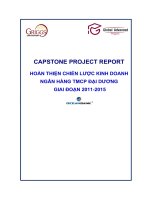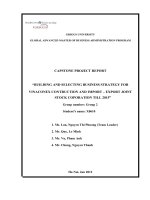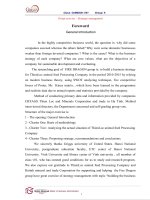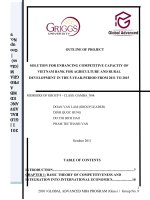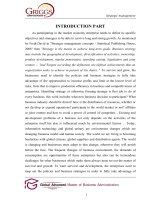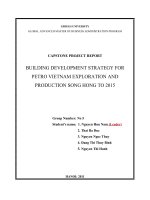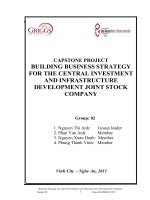Luận văn thạc sĩ quản trị kinh doanh quốc tế MBA (74)
Bạn đang xem bản rút gọn của tài liệu. Xem và tải ngay bản đầy đủ của tài liệu tại đây (995.15 KB, 91 trang )
CAPSTONE PROJECT REPORT
IMPROVING THE BUSINESS STRATEGY
OF MECHANICAL EXECUTION CONSTRUCTION JOINT STOCK
COMPANY, PERIOD 2020-2025
GRIGGS UNIVERSITY
GLOBAL ADVANCED MASTER OF BUSINESS ADMINISTRATION
PROGRAM
CAPSTONE PROJECT REPORT
IMPROVING THE BUSINESS STRATEGY
OF MECHANICAL EXECUTION CONSTRUCTION JOINT STOCK
COMPANY, PERIOD 2010-2015
Group No.11:
Hoang Hai Chau-Leader
Le Van Quan
Ngo Vu Thang
Nguyen Van Dung
Hanoi, 2009
TABLE OF CONTENTS
TABLE OF CONTENTS
LIST OF TABLES/FIGURES
EXECUTIVE SUMMARY
PREFACE
1
3
4
6
CHAPTER 1: THEORETICAL BACKGROUND ON COMPETITIVE STRATEGY
9
1.1. Business strategy overview
1.1.1.Definition of business strategy
1.1.2. Role of business strategy
1.1.3. Strategy hierarchy
1.1.3.1. Corporate Strategy
1.1.3.2. Business Unit Strategy:
1.1.3.3. Operational Strategy:
1.1.4. Strategic planning process
1.2. Environmental Analysis
1.2.1. Macro environmental analysis.
1.2.2. Industry environment Analysis
1.2.3. Internal environment Analysis
1.2.4. The synthesis of business environment of enterprise
1.3. Types of competitive strategies
1.3.1. Cost Leadership strategy
1.3.2. Differentiation strategy
13.3. Focus or Niche strategy.
1.3.4 A Combination of Generic Strategies
1.3.5. Selecting the optimum strategy
1.4. Strategy formulation and evaluation
1.4.1. Strategy formulation
9
9
10
11
11
11
11
12
12
14
16
20
27
28
29
30
30
31
31
33
33
34
1.4.2. Strategy evaluation and control
CHAPTER II: CURRENT SITUATION OF THE BUSINESS PERFORMANCE OF
THE MECHANIZED CONSTRUCTION JOINT STOCK COMPANY
2.1. Company Overview
2.1.1. Historical background
2.1.2. Company name
2.1.3. Head office
2.1.4. Key business domain
2.1.5. Operation model
2.1.6. Quality Control
2.1.7. General Capacity
36
36
36
36
37
37
37
38
38
38
2.1.8. Some economic ratios on business performance
2.1.9. Experience profile
2.2. Current business performance of the Mechanized & Construction Company
2.2.1 The business performance in recent 3 years
2.2.2 Business management
2.2.3 Corporate finance
2.3. External environment analysis
2.3.1. Macro environment analysis
2.3.2. Industry environment analysis
2.4. Internal environment analysis
2.4.1. Strengths
2.4.2 Weaknesses
CHAPTER III: IMPROVING THE BUSINESS STRATEGY OF THE
MECHANIZED AND CONSTRUCTION JOINT STOCK
COMPANY, PERIOD 2010-2015
41
41
42
42
46
49
50
50
55
64
64
65
69
3.1. The mission in period of 2009 - 2015
3.2. Strategic objectives in key business operation to 2015
3.2.1. Construction:
3.2.2. Land and Property:
3.3. Business strategy
3.3.1. Two key business fields
3.3.2. Other business fields:
3.4. Restructuring the company
3.4.1. Changing managagement structure of the mothe company:
3.4.2. Forming of core companies
3.4.3. Role of the mechanized and construction joint stock company
3.5. Building an efficient and transparent management model
3.5.1.Improving the management model and innovating the
management and administration style
3.5.2. Building a modern business financial management strategy
3.6. Detailed action plan for development strategy implementation
69
74
74
74
75
75
78
78
78
79
81
82
CONCLUSION
85
87
REFERENCES
2
82
82
LIST OF TABLES
Table 1.1: Marco environmental factors
Table 1.2: Simplified SWOT analysis Frame\
Table 1.3: Synthesis of business environment
Table 1.4: GREAT Quantitative Matrix
Table 2.1: Number of employees by specialization
Table 2.2: Key economic ratios
Table 2.3: Years of experience by operation
Table 2.4: List of investment project
Table 2.5: List of some contracts completed in the last 3 years
Table 2.6: Structure of revenue by business sectors during 2005 - 2007 and 6 first
months of 2008
Table 2.7: Structure of profit before tax during 2005- 2007
LIST OF FIGURES
Figure 1.1. Process of Strategic formulation and implementation
Figure 1.2: The business environmental factors
Figure 1.3: Micheal Porter’s 5 force model
Figure 1.4 Competitor analysis
Figure 1.5: Resources for business operation
Figure 1.6: SWOT Analysis Model
Figure 1.7: Micheal Porter’s generic strategies
Figure 2.1: The organizational chart of the Mechanized Construction JSC.
Figure 2.2: Structure of assets
Figure 2.3: Structure of Revenue
Figure 2.4: Structure of profit
Figure 2.5: GDP Growth 2002-2007
Figure 3.1: Organizational chart of the mechanized and construction joint stock
company (proposed)
3
EXECUTIVE SUMMARY
Mechanized and Construction Joint Stock Company, which initially was the
mechanical execution unit founded since 1959. On February 2, 1961, the company
was honorably given the "3rd Labor Medal" by President Ho Chi Minh – President of
the Democratic Republic of Vietnam.
Mechanized and Construction Company was
found in accordance with the decision No 147A/BXD-TCLĐ dated March 26, 1993
and on December 28,2007 the company was transformed into Mechanized and
Construction Joint Stock Company following the Decision No 2075/QĐ-BXD by the
Ministry of Construction. Together with the development and integration of the
country, the Mechanized and Construction Joint Stock Company became one of the
biggest companies in the execution of ground and base, industrial and transportation
construction, especially constructions which require consolidated base and ground
ranging from simple methods such as steel sheet piling, concrete piling to modern
methods such as sandy piling, cement piling, ...With a staffs of managers and
engineers with good qualification and experience, equipped with a system of modern
execution machineries made in developed countries such as Germany, Japan, Italy…
the company has executed many constructions all over the countries and gained the
credit of many investors. Recently, in the light of market potential and business
opportunities, the company has expanded and diversified its business operation,
involving in construction projects of infrastructure and urban areas such as 54 Ha
Dinh apartment and office building, Que Vo sustainable ecology resort, constructions
of urban areas in Xuan Dinh, Tu Liem, Ha Noi, Hon Ro Resort in Nha Trang…
In the last few years, Mechanized and Construction Joint Stock Company was proud
to be a construction unit which is able to take over big and significant constructions in
terms of social, economic and technical features all over the country.
In order to adapt to the market changes, continue to remain its growth speed and bring
into play all its strengths to enhance the company’s development to a new level in the
future, the company worked out a strategic vision to 2015.
4
To realize that vision, Mechanized and Construction Joint Stock Company need a
suitable business strategy to restructure the company organization, focus on the two
spearing business operation which are construction and property trading in an aim to
head for a new development level and better business performance. At the same time,
the company will keep innovating its management style, improving its business
administration and developing a long term financial strategy.
In this study, our group conducted an analysis on the external and internal
environment of the company and based on that to formulate a detailed business
strategy for the company to 2015.
5
PREFACE
1. Rationale
Mechanized and Construction Joint Stock Company, a member company of Hanoi
Construction Corporation, was found in 1959 in accordance with the foundation
decision No 147A/BXD-TCLĐ dated 26/03/1993.
It was transformed from a Mechanized and Construction state enterprise into
Mechanized and Construction Joint Stock Company following the decision No
2075/QĐ-BXD dated 28/12/2004 by Ministry of Construction.
Despite it’s the companying status, Mechanical Execution and Construction Joint
Stock Company has become a strong company in construction and execution of
ground and base for industrial, civil and transportation constructions. In such an
economic integration context, the company needs a suitable strategy and
development road map, which will improve the management model, restructure the
business organization and innovate the management style in order to adapt to the
new business environment.
2. Research objective
The development strategy will aim at achieving the development objectives to 2015
for the company, for which, the strategic planning process should cover following
main issues:
- Analysis of the current business performance model of the company;
- Analysis of Strengths, weaknesses, opportunities and challenges of the
company
- Analysis of the market and industrial tendencies of the business domain of
the company
6
- Proposal of a detailed development strategy for the company in the period of
2010 -2015;
3.Research scope
This research is limited to the key business operation of Mechanized and
Construction Joint Stock Company and an analysis of industrial trends, a
comparison with some typical enterprises in the same industry, which will serve as
premises to define a suitable strategy for the Mechanized and Construction Joint
Stock Company
4. Research significance
This research will give a description on the overall situation of the company, the
market development trends, which will help to build a vision and strategic
orientation for the company’s development in coming years.
We do hope the research outcomes will be applied in the company’s operation, help
to define a good vision with a suitable strategy to be of helpful in practice.
5. Research methodology
This research will be conducted by following methods:
Step 1: Data collection
- Documents provided by the Mechanized and Construction Joint Stock
Company
- Relating references
- Practical observation at the company
- Direct interview with managers of the company
7
Step 2: Data Analysis
- Synthesis and Comparison method : Compare the date of different years for
conclusion
- Method of induction: Go from small issues to the general conclusion
- SWAT analysis: Used to analyze and process the study on business
environment, enabling a scientific strategic planning.
6. Research structure
Chapter 1:
Chapter 2:
Chapter 3:
Theoretical background on competitive strategy
Current situation of the business performance of the mechanized
construction joint stock company
Improving the business strategy of the mechanized and construction
joint stock company, period 2010-2015
8
CHAPTER 1
THEORETICAL BACKGROUND ON COMPETITIVE STRATEGY
1.1. Business strategy overview
1.1.1. Definition of business strategy
Strategy definition has been existed for long times, it can be understood as “a
science of operation planning and controlling” (Webster’s New World). This
terminology was first used for military. Gradually, together with the development
of market economy, the strategy notion is used in business.
There are various definitions on strategy. We hereby would like to present some
typical understandings:
- “Strategy is an important direction and scope for an organization in long-term to
gain the competitive advantage by defining its resources in analysis changing
environment to meet the market demand and satisfy the expectation of its
stakeholders” (Johnson G. , Scholes K. , 1999, Exploring Corporate Strategy. 5th
Ed. Prentice Hall Europe)
- “Strategy is a range of interactive activities aiming at the mobilization of all the
possible resources to achieve a defined purpose”. (GaMBA, 2009, Text book on
strategic management, Strategy Definition, p. 1).
- “Strategy includes ideas, plans and support sustainable for an enterprise to
compete successfully over its competitors ” (Strategic management, p. 6 – Le The
Gioi, Nguyen Thanh Liem, Tran Huu Hai – Statistical Publishing House 2009)
- In 19632, Chandler defined strategy as : “The defining of basic and long-term
objectives of enterprise and the application of a range of necessary activities
9
together with resources allocation in order to achieve those objectives” (Strategic
management – production. 10- Le The Gioi, Nguyen Thanh Liem, Tran Huu Hai –
Statistical Publishing House 2009)
The definition of business strategy is a long term plan of action designed to achieve
a particular goal or set of goals or objectives. Strategy is management's game plan
for strengthening the performance of the enterprise. It states how business should
be conduct to achieve the desired goals. Without a strategy management has no
roadmap to guide them.
Creating a business strategy is a core management function. It must be said that
having a good strategy and executing the strategy well, does not guarantee success.
Organisations can face unforeseen circumstances and adverse conditions through
no fault of their own.
To be successful today, the company must become competitor-oriented. In pursuing
the right competitive strategy – avoid strengths of competitors and look for weak
points in their positions and then launch marketing attacks against those weak
points.
1.1.2. Role of business strategy
The business strategy of a company provides the big picture that shows how all the
individual activities are coordinated to achieve a desired end result. It is through
the strategy process that the overall direction of the company is set. This is based
on the opportunities and threats in the outside world and the internal strengths and
weaknesses of the business.
As the external environment changes, perhaps due to changes in customers or
competitors or perhaps due to the wider forces - political, economic, social,
technological, and environmental or legislation based - it is important to come back
10
and ask some fundamental questions. The more external environment changes, then
the more opportunities there are likely to be for the well prepared company but the
more threats the unwary and the unprepared will face.
But even if the basic environment is stable, competitive actions change and
companies need to review what is happening, prepare for any real or potential
competitive advantages and find new insights into ways to create value for
customers.
1.1.3. Strategy hierarchy
Strategies exist at several levels in any organisation - ranging from the overall
business (or group of businesses) through to individuals working in it.
1.1.3.1. Corporate Strategy
Corporate Strategy - is concerned with the overall purpose and scope of the
business to meet stakeholder expectations. This is a crucial level since it is heavily
influenced by investors in the business and acts to guide strategic decision-making
throughout the business. Corporate strategy is often stated explicitly in a "mission
statement".
1.1.3.2. Business Unit Strategy
Business Unit Strategy - is concerned more with how a business competes
successfully in a particular market. It concerns strategic decisions about choice of
products, meeting needs of customers, gaining advantage over competitors,
exploiting or creating new opportunities etc.
11
1.1.3.3. Operational Strategy:
Operational Strategy - is concerned with how each part of the business is organised
to deliver the corporate and business-unit level strategic direction. Operational
strategy therefore focuses on issues of resources, processes, people etc
1.1.4. Strategic planning process
The strategic planning process can be described as followed:
Figure 1.1. Process of Strategic formulation and implementation
Step 1
Step 2
Step 3
Step 4
Develop a
strategic
vision
Set up
objectives
Build up a
strategy to
achieve
objectives
Implement
and comply
with the
strategy
Step 5
Evaluate, control
and adjust the
strategy
Change as requested by the real context,
changes of conditions, opportunities and new
initiatives
1.2. Environmental Analysis
Environmental analysis is the study of the organizational environment to point out
environmental factors that can significantly influence organizational operations.
Environmental analysis will help business managers understand what is happening
both inside and outside the organization and to increase the probability that the
organizational strategies developed will appropriately reflect organizational
environment.
12
In order to perform an environmental analysis, the company must thoroughly
understand how organizational environments are structured. For purposes of
environmental analysis, the company can divide the environment of organization
into three distinct levels: internal environment, operating environment, and general
environment.
Figure 1.2: The business environmental factors
The Macro Environment Analysis is traditionally the first step of a strategic
analysis; it is sometimes referred to as an external analysis, a pest analysis or a
pestle analysis.
The purpose of the Macro Environment Analysis is to identify possible
opportunities and threats to industry as a whole that are outside the control of
industry. When completing a macro environment analyses the company will be
seeking to answer the questions “what will affect the growth of our industry as a
whole” and “What is the likely impact of all of the things that affect the growth of
industry”
13
1.2.1. Macro environmental analysis.
There are many factors in the macro-environment that will effect the decisions of
the managers of any organization. Tax changes, new laws, trade barriers,
demographic change and government policy changes are all examples of macro
change. To help analyze these factors managers can categories them using the
PESTEL model. This classification distinguishes between:
Political factors. These refer to government policy such as the degree of
intervention in the economy. What goods and services does a government want to
provide? To what extent does it believe in subsidizing firms? What are its priorities
in terms of business support? Political decisions can impact on many vital areas for
business such as the education of the workforce, the health of the nation and the
quality of the infrastructure of the economy such as the road and rail system.
Economic factors. These include interest rates, taxation changes, economic growth,
inflation and exchange rates
Social factors. Changes in social trends can impact on the demand for a firm's
products and the availability and willingness of individuals to work.
Technological factors: new technologies create new products and new processes.
MP3 players, computer games, online gambling and high definition TVs are all
new markets created by technological advances. Online shopping, bar coding and
computer aided design are all improvements to the way we do business as a result
of better technology. Technology can reduce costs, improve quality and lead to
innovation. These developments can benefit consumers as well as the organizations
providing the products.
Environmental factors: environmental factors include the weather and climate
change. Changes in temperature can impact on many industries including farming,
14
tourism and insurance. With major climate changes occurring due to global
warming and with greater environmental awareness this external factor is
becoming a significant issue for firms to consider. The growing desire to protect the
environment is having an impact on many industries such as the travel and
transportation industries (for example, more taxes being placed on air travel and the
success of hybrid cars) and the general move towards more environmentally
friendly products and processes is affecting demand patterns and creating business
opportunities.
Legal factors: these are related to the legal environment in which firms operate. In
recent years there have been many significant legal changes that have affected
firms' behavior. The introduction of age discrimination and disability
discrimination legislation, an increase in the minimum wage and greater
requirements for firms to recycle are examples of relatively recent laws that affect
an organization’s actions. Legal changes can affect a firm's costs (e.g. if new
systems and procedures have to be developed) and demand (e.g. if the law affects
the likelihood of customers buying the good or using the service).
Table 1.1 Marco environmental factors
Economic
Political & legal
factors
factors
Regulations on
Stages of
economic cycle
Money supply
GNP trend
consumption
lending
Anti-monopoly
regulations
Law of
environmental
protection
Inflation
Tax regulations
Interest rate
Regulations in
Social factors
Natural
Technological
factors
factors
Cost for R&D
Viewpoints
Environment
on life styles
al pollutions
Life styles
Women
labors
Shortage of
energy
Waste of
natural
resources
from state
budget
Cost for R&D
of the industry
Technological
highlights
Career
Property right
expectation
Positive
protection
Transfer of new
15
Monetary
policies
Unemployment
rate
Financial
policies
Control on
foreign trade
Preferential
policies
Regulations on
hiring and
promotion
Political stability
consumption
technology
Birth rate
New products
Population
increase rate
Population
movements
Usage of human
being or
machineries
Automatic
price wage
Balance of
payment
1.2.2. Industry environment analysis
"Porter's five forces" is a framework for the industry analysis and business strategy
development developed by Michael E. Porter of Harvard Business School in 1979.
Porter's five force include three forces from 'horizontal' competition: threat of
substitute products, the threat of established rivals, and the threat of new entrants;
and two forces from 'vertical' competition: the bargaining power of suppliers and
the bargaining power of customers.
Figure 1.3: Micheal Porter’s 5 force model
16
According to Porter, the five forces model should be used at the industry level; it is
not designed to be used at the industry group or industry sector level. An industry is
defined at a lower, more basic level: a market in which similar or closely related
products and/or services are sold to buyers. A firm that competes in a single
industry should develop, at a minimum, one five forces analysis for its industry.
Porter makes clear that for diversified companies, the first fundamental issue in
corporate strategy is the selection of industries (lines of business) in which the
company should compete; and each line of business should develop its own,
industry-specific, five forces analysis.
a) Rivalry.
The intensity of rivalry between competitors in an industry will depend on:
-
The structure of competition - for example, rivalry is more intense where there
are many small or equally sized competitors; rivalry is less when an industry
has a clear market leader
The structure of industry costs - for example, industries with high fixed costs
encourage competitors to fill unused capacity by price cutting
-
Degree of differentiation - industries where products are commodities (e.g.
steel, coal) have greater rivalry; industries where competitors can differentiate
their products have less rivalry
17
-
Switching costs - rivalry is reduced where buyers have high switching costs i.e. there is a significant cost associated with the decision to buy a product from
an alternative supplier
-
Strategic objectives - when competitors are pursuing aggressive growth
strategies, rivalry is more intense. Where competitors are "milking" profits in a
mature industry, the degree of rivalry is less
Exit barriers - when barriers to leaving an industry are high (e.g. the cost of closing
down factories) - then competitors tend to exhibit greater rivalry
Figure 1.4 Competitor analysis
What the competitors
can do
What the competitors
are expecting
Some questions should be
answered about competitors
Future purpose
All the
management
levels
- Do the competitors satisfy about
their current position?
- What are their abilities?
- What are their weaknesses?
- What can help them to win in
competition?
Comments
Their affect and the
industry
Current
strategy
What’s the
current
competition of
the enterprise
Potential
Strengths and
weaknesses
b) Bargaining Power of Buyers
18
Buyers are the people / organizations who create demand in an industry. The
bargaining power of buyers is greater when:
- There are few dominant buyers and many sellers in the industry
- Products are standardized
- Buyers threaten to integrate backward into the industry
- Suppliers do not threaten to integrate forward into the buyer's industry
- The industry is not a key supplying group for buyers
c) Bargaining Power of Suppliers
Suppliers are the businesses that supply materials & other products into the
industry. The cost of items bought from suppliers (e.g. raw materials, components)
can have a significant impact on a company's profitability. If suppliers have high
bargaining power over a company, then in theory the company's industry is less
attractive. The bargaining power of suppliers will be high when:
- There are many buyers and few dominant suppliers
- There are undifferentiated, highly valued products
- Suppliers threaten to integrate forward into the industry (e.g. brand
manufacturers threatening to set up their own retail outlets)
-
Buyers do not threaten to integrate backwards into supply
- The industry is not a key customer group to the suppliers
d) Threat of New Entrants
New entrants to an industry can raise the level of competition, thereby reducing its
attractiveness. The threat of new entrants largely depends on the barriers to entry.
High entry barriers exist in some industries (e.g. shipbuilding) whereas other
industries are very easy to enter (e.g. estate agency, restaurants). Key barriers to
entry include
19
- Economies of scale
- Capital / investment requirements
- Customer switching costs
- Access to industry distribution channels
- The likelihood of retaliation from existing industry players.
e) Threat of Substitutes
The presence of substitute products can lower industry attractiveness and
profitability because they limit price levels. The threat of substitute products
depends on:
- Buyers' willingness to substitute
- The relative price and performance of substitutes
- The costs of switching to substitutes
1.2.3. Internal environment Analysis
The Internal Analysis of strengths and weaknesses focuses on internal factors that
give an organization certain advantages and disadvantages in meeting the needs of
its target market. Strengths refer to core competencies that give the firm an
advantage in meeting the needs of its target markets. Any analysis of company
strengths should be market oriented/customer focused because strengths are only
meaningful when they assist the firm in meeting customer needs. Weaknesses refer
to any limitations a company faces in developing or implementing a strategy.
Weaknesses should also be examined from a customer perspective because
customers often perceive weaknesses that a company cannot see
Understanding a business in depth is the goal of internal analysis. This analysis is
based resources and capabilities of the firm.
1.2.3.1 Resources
20
A good starting point to identify company resources is to look at tangible,
intangible and human resources.
Figure 1.5: Resources for business operation
Tangible resources are the easiest to identify and evaluate: financial resources and
physical assets are identifies and valued in the firm’s financial statements.
Intangible resources are largely invisible, but over time become more important to
the firm than tangible assets because they can be a main source for a competitive
advantage. Such intangible recourses include reputation assets (brands, image, etc.)
and technological assets (proprietary technology and know-how).
21
Human resources or human capital are the productive services human beings offer
the firm in terms of their skills, knowledge, reasoning, and decision-making
abilities.
1.2.3.2 Capabilities
a) Production activities
Analysis of production process involves reviewing the process of making products
to make sure if it match well with the business strategy of enterprise or not and
make necessary innovation and improvement.
- Analysis of production capacity: production capacity is the ability to produce
some certain volume of products according to certain standards at certain
periods. It shows the concentration of production resources such as:
equipments and technology.
- Analysis of the supply of production inputs such as energy, raw materials,
and components: which mainly involve the analysis of quality, reliability,
timeliness of resources?
- Analysis of reasonability in the production process: Mainly refer to the
analysis of production organization and its operation, the continuous function
and adaptation of production technology and equipments when there’s
change of products.
- Analysis of quality control: focus on the importance of quality control
management and its efficiency.
b)Marketing activities
Marketing strategy is a functional strategy which play important role in
implementing business strategy of the company.
22
Market enables the company to create value in some other activities. By brand
positioning and advertising, Market function can increase the awareness of
customers about the product values. Moreover, these activities also make it possible
to create a good impression about products in the customers’ mind, which will then
increase the value. Marketing and sales activities can also create the value by
realizing the customers need and then communicating with the R& D departments
to design more satisfactory products.
c) Management activities
Business management is a set of supporting activities used to facilitate the primary
activities in the company value chain...
* Firm Infrastructure: This activity includes and is driven by corporate or strategic
planning. It includes the Management Information System (MIS) and other
mechanisms for planning and control such as the accounting department.
* Human Resource Management (HRM): Employees are an expensive and vital
resource. An organization would manage recruitment and s election, training and
development, and rewards and remuneration. The mission and objectives of the
organization would be driving force behind the HRM strategy. The goal of human
resource management is to help an organization to meet strategic goals by
attracting, and maintaining employees and also to manage them effectively.
* Resources management: This function is responsible for all purchasing of goods,
services and materials. The aim is to secure the lowest possible price for purchases
of the highest possible quality. They will be responsible for outsourcing
(components or operations that would normally be done in-house are done by other
organizations), and e-Purchasing (using IT and web-based technologies to achieve
procurement aims).
23
